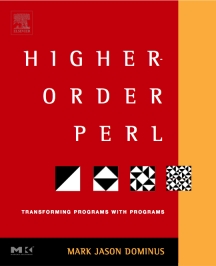
|
FreeComputerBooks.com
Links to Free Computer, Mathematics, Technical Books all over the World
|
|
- Title: Higher-Order Perl: Transforming Programs with Programs
- Authors Mark Jason Dominus
- Publisher: Morgan Kaufmann (March 28, 2005)
- Paperback: 600 pages
- Language: English
- ISBN-10: 1558607013
- ISBN-13: 978-1558607019
- Share This:

|
This is a book written with the goal to teach Perl programmers with a strong C and Unix background how to use techniques with roots in functional programming languages like Lisp that are available in Perl as well, but less known.
Most Perl programmers were originally trained as C and Unix programmers, so the Perl programs that they write bear a strong resemblance to C programs. However, Perl incorporates many features that have their roots in other languages such as Lisp. These advanced features are not well understood and are rarely used by most Perl programmers, but they are very powerful. They can automate tasks in everyday programming that are difficult to solve in any other way. One of the most powerful of these techniques is writing functions that manufacture or modify other functions. For example, instead of writing ten similar functions, a programmer can write a general pattern or framework that can then create the functions as needed according to the pattern.
For several years Mark Jason Dominus has worked to apply functional programming techniques to Perl. Now Mark brings these flexible programming methods that he has successfully taught in numerous tutorials and training sessions to a wider audience.
- Introduces powerful programming methods - new to most Perl programmers - that were previously the domain of computer scientists
- Gradually builds up confidence by describing techniques of progressive sophistication
- Shows how to improve everyday programs and includes numerous engaging code examples to illustrate the methods
- Mark Jason Dominus has been programming in Perl professionally since 1992, when he was a UNIX sysadmin with the University of Pennsylvania Department of Computer and Information Sciences. Mark is an occasional contributor to the Perl Core, and is the author of the standard perlreftut man page as well as the Tie::File, Text::Template, and Memoize modules. From 1999-2001, Mark was the managing editor of the www.perl.com website. He was also a columnist for The Perl Journal for several years.
- PERL Programming
- Python Programming
- The C and Objective C Programming
- Functional Programming
- Unix/Linux Shell Programming
- Ruby and Ruby on Rails Programming

- Higher-Order Perl: Transforming Programs with Programs (Mark Jason Dominus)
- The Mirror Site (1) - ePub
-
 Perl 6 (Raku) at a Glance by Andrew Shitov
Perl 6 (Raku) at a Glance by Andrew Shitov
This book is about Perl 6 (Raku), a programming language of the Perl family. It covers many basic and in-depth topics of the language and provides the initial knowledge you need to start working with Perl 6.
-
 Think Perl 6 (Raku): How to Think Like a Computer Scientist
Think Perl 6 (Raku): How to Think Like a Computer Scientist
This practical guide gets you started on your programming journey with the help of Perl 6 (Raku), the younger sister of the popular Perl programming language. Ideal for beginners, this hands-on book includes over 100 exercises with multiple solutions.
-
 Using Perl 6 (Raku) by Jonathan S. Duff, et al
Using Perl 6 (Raku) by Jonathan S. Duff, et al
This book is primarily for people who want to learn Perl 6 (Raku). It teaches the basics from a Perl 6 perspective, touching on variable interpolation, datastructure use, object construction, threads, closures, symbol tables, and other core features.
-
 Mastering Perl/Tk (Steve Lidie, et al)
Mastering Perl/Tk (Steve Lidie, et al)
Perl/Tk is the marriage of the Tk graphical toolkit with Perl, the powerful programming language used primarily for system administration, web programming, and database manipulation. With Perl/Tk, you can build Perl programs with an attractive.
-
 O'Reilly® Perl and LWP (Sean M. Burke)
O'Reilly® Perl and LWP (Sean M. Burke)
This book sets out to unwrap the Library for the Web in Perl (LWP), which is a collection of modules that make it easier to access and pick apart Web pages (and FTP-accessible files, and outgoing e-mail messages) from within your Perl programs.
-
 Beginning Perl (Simon Cozens)
Beginning Perl (Simon Cozens)
The book promotes the use of Perl as a programming language, encouraging the creation of legible and sensible programs so as to dispel the image of Perl as a confusing and obscure language.
-
 Modern Perl (chromatic)
Modern Perl (chromatic)
Describe how experienced and effective Perl 5 programmers work. They use language idioms. They take advantage of the CPAN. They're recognizably Perlish, and they show good taste and craftsmanship and a full understanding of Perl.
-
 Beginning Perl (Curtis 'Ovid' Poe)
Beginning Perl (Curtis 'Ovid' Poe)
This book introduces Perl to both new programmers and experienced ones who are looking to learn a new language. It provides the information and instruction you need to confidently get started with Perl.
-
 Exploring Programming Language Architecture in Perl (Bill Hails)
Exploring Programming Language Architecture in Perl (Bill Hails)
This book presents an informal and friendly introduction to some of the core ideas in modern computer science, using the programming language Perl as its vehicle. It The book takes the form of a series of working interpreters for the language PScheme.
-
 Perl for the Web (Chris Radcliff)
Perl for the Web (Chris Radcliff)
This book provides tools and strategies to improve the performance of existing Web applications in Perl with case studies and real-world examples. It also provides principles and ideas that help programmers create extensible frameworks.





